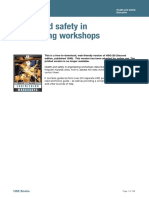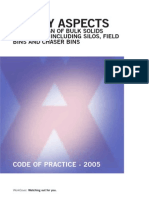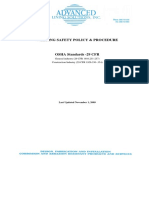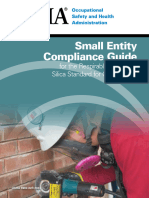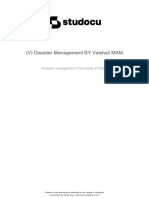Advice For Managers: COSHH Essentials For Welding, Hot Work and Allied Processes
Advice For Managers: COSHH Essentials For Welding, Hot Work and Allied Processes
Uploaded by
Dan RotariCopyright:
Available Formats
Advice For Managers: COSHH Essentials For Welding, Hot Work and Allied Processes
Advice For Managers: COSHH Essentials For Welding, Hot Work and Allied Processes
Uploaded by
Dan RotariOriginal Title
Copyright
Available Formats
Share this document
Did you find this document useful?
Is this content inappropriate?
Copyright:
Available Formats
Advice For Managers: COSHH Essentials For Welding, Hot Work and Allied Processes
Advice For Managers: COSHH Essentials For Welding, Hot Work and Allied Processes
Uploaded by
Dan RotariCopyright:
Available Formats
Health and Safety
Executive
WL0 Advice for managers
COSHH essentials for
welding, hot work and
allied processes
The Control of Substances Introduction
Hazardous to Health HSE has produced these advice sheets to help employers assess and
Regulations 2002 (COSHH) control risks from hazardous substances in the workplace. For some
require employers to ensure common welding and allied process tasks, the advice sheets take into
that exposure is prevented or, account the health hazards (and exposure potential) of substances used
where this is not reasonably or produced to identify an approach appropriate to control the risks.
practicable, adequately
controlled. This guidance gives The WL series of guidance sheets describes good practice for
practical advice on how this controlling exposure to welding fume and allied processes. It is likely
can be achieved by applying that you will require more than one guidance sheet to provide you with
the principles of good practice information on the controls relevant to your specific task or process. By
for the control of exposure to entering your process information in the COSHH essentials web tool, a
substances hazardous to health, list of guidance sheets and a list of additional relevant guidance sheets
as required by COSHH. become available. The WL series is located on the web tool under the
sub-headings: Direct Advice, Production Industries, Welding and Cutting.
It is aimed at people whose
responsibilities include the What the WL sheets cover
management of substances The WL control guidance sheets (listed below) describe good practice
hazardous to health at work for controlling exposure to hazardous substances in the welding industry.
(eg occupational health
specialists, anyone undertaking WL0 Advice for managers
COSHH assessments and WL1 Withdrawn
supervisors). It is also useful for
WL2 Welding in confined/limited/restricted spaces
trade union and employee safety
representatives). It will help you WL3 Welding fume control
carry out COSHH assessments, WL4 Withdrawn
review existing assessments, WL5 Withdrawn
deliver training and supervise
activities involving substances WL6 Withdrawn
hazardous to health. WL7 Withdrawn
This guidance is issued by the WL8 Withdrawn
Health and Safety Executive. WL9 Withdrawn
Following the guidance is not WL10 Withdrawn
compulsory, unless specifically
WL11 Withdrawn
stated, and you are free to
take other action. But if you do WL12 Withdrawn
follow the guidance, you will WL13 Withdrawn
normally be doing enough to WL14 Manual gas and oxy-gas cutting
comply with the law. Health and
WL15 Plasma arc cutting: fixed equipment
safety inspectors seek to secure
compliance with the law and WL16 Arc-air gouging (air-carbon arc gouging)
may refer to this guidance. WL17 Withdrawn
See Essential information near WL18 Surface preparation: pressure blasting (small items)
the end of the sheet. WL19 Surface preparation: pressure blasting (medium-sized items)
WL20 Surface preparation: pressure blasting (large items)
WL21 Weld cleaning with pickling paste
Welding, hot work and allied processes - WL0 - Advice for managers Health and Safety
Executive
Hazards
Welding fume (which includes irritating gases such as oxides of
nitrogen and ozone) may cause respiratory irritation and metal fume
fever. It can also increase susceptibility to pneumonia. In the longer
term, it can lead to serious lung diseases including: chronic obstructive
pulmonary disease (COPD), which used to be called chronic bronchitis,
and emphysema, occupational asthma and cancer.
Shielding gases (such as argon, helium and nitrogen, or argon-based
mixtures containing carbon dioxide, oxygen or both) can cause
asphyxiation (suffocation from lack of oxygen), usually resulting from
accumulation of the gases in confined spaces.
Fume and dust from allied processes, eg flame and arc cutting, blasting
and post-weld dressing, can cause lung disease. Abrasive blasting
produces a great deal of dust that includes metals and metal oxides.
Each situation is different. The hazard varies and is dependent on the
process, eg the welding consumable, the base metal, surface coatings
or contaminants, and where the task is done.
Other COSHH requirements
You may need to undertake an exposure measurement survey,
which will involve air sampling and, for some specific hazardous
substances, biological monitoring would also be appropriate. Exposure
measurements help to determine whether the current control measures
are effectively protecting the health of the workers or if improvements
to the control strategy are needed. See the General Control Guidance
Sheet G409 Exposure Measurement: Air sampling, which has advice
on selecting a competent person to conduct the measurement survey.
It is important to note that there is a British Standard for sampling
welding fume, which the competent person undertaking the sampling
can follow: ISO10882 Health and Safety in Welding and Allied
Processes – Sampling of airborne particles and gases in the operators’
breathing zone Parts 1 and 2.
You may need to carry out health surveillance for workers. See
the General Control Guidance Sheets on health surveillance for
occupational asthma (G402) and health monitoring for COPD (G401).
Lead exposure from welding, cutting and blasting metal which is
coated in a lead-based paint will need a separate assessment and
health surveillance carried out in accordance with the Control of Lead
at Work Regulations 2002, Approved Code of Practice (ACOP L132).
How to use the sheets
✓✓ Consider the processes/tasks and hazardous substances in your
workplace.
✓✓ Consider using alternative joining, cutting or surface preparation
methods that produce less fume or dust.
✓✓ Examine the advice sheets for each of the tasks.
✓✓ Examine the essential information sheets listed on each advice sheet.
✓✓ Compare operations in your workplace with recommendations in the
advice sheets for all of the relevant tasks.
✓✓ Record significant findings (this forms part of your risk assessment).
Welding, hot work and allied processes - WL0 - Advice for managers Health and Safety
Executive
✓✓ Record any actions you need to take covering: issues identified,
planned actions, target completion date, person responsible, status of
any issues and a review of their effectiveness.
✓✓ Keep a record of your actions to prevent or reduce exposure of
workers to hazardous substances.
✓✓ You may have to change old working practices or implement new
controls. Decide how best to make any changes required ‘across
the board’. If you are in doubt, seek expert help. Ask your trade
association, trade union or contact a consultant (see Further
information).
Essential information
You can find the full COSHH essentials series at:
www.hse.gov.uk/coshh/index.htm
Health surveillance, monitoring and sampling sheets are available at:
www.hse.gov.uk/pubns/guidance/gseries.htm
Health surveillance for occupational asthma COSHH guidance
sheet G402.
Further information
✓✓ HSG258 Controlling airborne contaminants at work: A guide to local
exhaust ventilation (LEV):
www.hse.gov.uk/pubns/books/hsg258.htm
✓✓ HSG53 Respiratory protective equipment at work -
A practical guide: www.hse.gov.uk/pubns/books/hsg53.htm
✓✓ Occupational Safety and Health Consultants Register: www.oshcr.org/
✓✓ The Control of Lead at Work Regulations 2002. (Third edition) ACOP
and guidance: www.hse.gov.uk/pubns/books/l132.htm
For information about health and safety, visit https://books.hse.gov.uk
or http://www.hse.gov.uk
You can view HSE guidance online and order priced publications from
the website. HSE priced publications are also available from bookshops.
To report inconsistencies or inaccuracies in this guidance email:
commissioning@wlt.com
© Crown copyright If you wish to reuse this information visit www.hse.gov.uk/copyright.htm for details. Published 11/19
Published for the Health and Safety Executive under licence from the Controller of Her Majesty’s Stationery Office.
You might also like
- Risk Assessment of Concrete PouringDocument13 pagesRisk Assessment of Concrete PouringAbdul Mujeeb100% (3)
- Loading Test Method Statement FinalDocument10 pagesLoading Test Method Statement FinalBOUZAIDANo ratings yet
- Sematech Safety Guide - SilaneDocument134 pagesSematech Safety Guide - SilaneTanmay DuttaNo ratings yet
- Plasma Arc Cutting: Fixed Equipment: Control Approach 2Document4 pagesPlasma Arc Cutting: Fixed Equipment: Control Approach 2Dan RotariNo ratings yet
- Ficha de Datos Ailica Control BandingDocument4 pagesFicha de Datos Ailica Control Bandingjamartinez110380No ratings yet
- HSE Free Ceramics COSHH For ManagersDocument3 pagesHSE Free Ceramics COSHH For ManagersTony RobertsNo ratings yet
- Health and Safety in Engineering Workshops Hsg129-1Document125 pagesHealth and Safety in Engineering Workshops Hsg129-1YeshitilaAyalewNo ratings yet
- Controlling Exposure To Manganese in Welding Fume - Lincoln ElectricDocument4 pagesControlling Exposure To Manganese in Welding Fume - Lincoln ElectricgobiNo ratings yet
- Arc-Air Gouging (Air-Carbon Arc Gouging) : Control Approach 2Document4 pagesArc-Air Gouging (Air-Carbon Arc Gouging) : Control Approach 2Dan RotariNo ratings yet
- Advice For Managers: Offshore Coshh EssentialsDocument4 pagesAdvice For Managers: Offshore Coshh Essentialsdutru2003No ratings yet
- Hse - Health and Safety in Engineer in WorkshopsDocument138 pagesHse - Health and Safety in Engineer in WorkshopsSleh FkiNo ratings yet
- hsg129 PDFDocument138 pageshsg129 PDFmanimeczNo ratings yet
- Construction EditedDocument14 pagesConstruction EditedsycwritersNo ratings yet
- Air Contaminants SP# 1910.1000: Quick ReferenceDocument7 pagesAir Contaminants SP# 1910.1000: Quick ReferenceWilly O RIveraNo ratings yet
- Ref. Monitoring-Exposure-To-Welding-Fume-V5Document4 pagesRef. Monitoring-Exposure-To-Welding-Fume-V5Sunil SEHSNo ratings yet
- Welding Fume Control: Control Approach 1 Control Approach 2Document9 pagesWelding Fume Control: Control Approach 1 Control Approach 2garden00589No ratings yet
- Strata Control in Underground Coal MinesDocument30 pagesStrata Control in Underground Coal MinesK-milo Ruiz100% (2)
- Design of Safe Bulk Solid Containers Code of Practice 1328 PDFDocument38 pagesDesign of Safe Bulk Solid Containers Code of Practice 1328 PDFDinh Viet HaiNo ratings yet
- A Practical Guide To Welding Fume ControlDocument20 pagesA Practical Guide To Welding Fume ControlVasudev MenonNo ratings yet
- NR 18 Controlling Silica Exposure in ConstructionDocument72 pagesNR 18 Controlling Silica Exposure in ConstructionCPSSTNo ratings yet
- Guidelines For Developing A Welding and Cutting Safety ProgramDocument3 pagesGuidelines For Developing A Welding and Cutting Safety ProgramMichael RujuwaNo ratings yet
- Design Safe Chemical Processes (Hsg143)Document64 pagesDesign Safe Chemical Processes (Hsg143)naveed11092No ratings yet
- Abrasive Blasting Cop 2013Document34 pagesAbrasive Blasting Cop 2013Ogala OscarNo ratings yet
- Welding ProcessesDocument30 pagesWelding ProcessesJeremiah NayosanNo ratings yet
- Welding Processes Cop 2021Document40 pagesWelding Processes Cop 2021Ruth CoronadoNo ratings yet
- Abrasive Blasting: Code of PracticeDocument38 pagesAbrasive Blasting: Code of PracticeRajanbabuNo ratings yet
- IIW-1719-05 Health and Safety of WeldersDocument7 pagesIIW-1719-05 Health and Safety of WeldersClaudia MmsNo ratings yet
- Als-Welding Safety Policy ProcedureDocument28 pagesAls-Welding Safety Policy ProcedureRicardoNo ratings yet
- Risk Management ManualDocument87 pagesRisk Management ManualAndre MarsNo ratings yet
- UKLA Good Practice Guide For Safe Handling and Disposal of Metalworking FluidsDocument50 pagesUKLA Good Practice Guide For Safe Handling and Disposal of Metalworking FluidsLiliNo ratings yet
- Ohsas in BriefDocument20 pagesOhsas in Briefrovin.raghavNo ratings yet
- CN4 Crushing and Screening Demolition MaterialDocument4 pagesCN4 Crushing and Screening Demolition MaterialAntónio PereiraNo ratings yet
- Safe Working at Heights Guide 1321Document52 pagesSafe Working at Heights Guide 1321Indra YudaNo ratings yet
- EHS Guidelines Offshore Oil and Gas June2015Document42 pagesEHS Guidelines Offshore Oil and Gas June2015IFC Sustainability100% (3)
- Abrasive Blasting: COSHH Essentials in Construction: Silica Engineering and RPEDocument4 pagesAbrasive Blasting: COSHH Essentials in Construction: Silica Engineering and RPEAditya PrajasNo ratings yet
- Eqpt IsolationDocument68 pagesEqpt IsolationDobrescu CristianNo ratings yet
- HSE HSG 244 (Ed 1 2004) - Remotely Operated Shutoff ValvesDocument37 pagesHSE HSG 244 (Ed 1 2004) - Remotely Operated Shutoff Valvesrees1098No ratings yet
- Ventilation of Underground MinesDocument30 pagesVentilation of Underground MinesMark EdowaiNo ratings yet
- Excavation WorkDocument43 pagesExcavation WorkJK AlmaNo ratings yet
- ABSS Abrasive-Blasting-Code-of-Practice-2015Document35 pagesABSS Abrasive-Blasting-Code-of-Practice-2015Youtube For Education100% (1)
- WSH Accident Advisory Worker Found With Upper Body in PipeDocument3 pagesWSH Accident Advisory Worker Found With Upper Body in PipekumarNo ratings yet
- Haz Subs RaDocument18 pagesHaz Subs RaYen Ling NgNo ratings yet
- Eh40 (WEL)Document80 pagesEh40 (WEL)Cip ZerkopNo ratings yet
- Risk Management ManualDocument88 pagesRisk Management ManualJL Fav100% (1)
- Excavation WorkDocument46 pagesExcavation WorkKarthikeyan Lakshmanan100% (1)
- Welding Safety Policy ProcedureDocument16 pagesWelding Safety Policy ProcedureIkyegh IshaNo ratings yet
- Welding Processes Code of Practice: APRIL 2016Document33 pagesWelding Processes Code of Practice: APRIL 2016awe_emNo ratings yet
- COSHH ( Control Of Substance Hazardous To Health.Document19 pagesCOSHH ( Control Of Substance Hazardous To Health.mohammadsahiransariNo ratings yet
- Change in Enforcement Expectations For Mild Steel Welding FumeDocument4 pagesChange in Enforcement Expectations For Mild Steel Welding FumePushkar GopalNo ratings yet
- HSEQ-HQ-06!16!00 Hydrogen Sulphide in Operations StandardDocument19 pagesHSEQ-HQ-06!16!00 Hydrogen Sulphide in Operations StandardagaricusNo ratings yet
- Hse HSG139Document43 pagesHse HSG139alain_oregioniNo ratings yet
- IPC Safety AuditDocument20 pagesIPC Safety Auditagrocel_bhv5591No ratings yet
- COSHH-in-labs-version-7_tcm18-35257Document10 pagesCOSHH-in-labs-version-7_tcm18-35257Hafed AbdulhadiNo ratings yet
- Unit 201: Ngineering: Working in EDocument2 pagesUnit 201: Ngineering: Working in EAbby TakarsNo ratings yet
- Osha 3902Document101 pagesOsha 3902Derecho Laboral IndividualNo ratings yet
- L122 Safety Of Pressure Systems: Pressure Systems Safety Regulations 2000. Approved Code of Practice and Guidance on Regulations, L122From EverandL122 Safety Of Pressure Systems: Pressure Systems Safety Regulations 2000. Approved Code of Practice and Guidance on Regulations, L122No ratings yet
- The Manufacture of Sterile Pharmaceuticals and Liquid Medical Devices Using Blow-Fill-Seal Technology: Points to ConsiderFrom EverandThe Manufacture of Sterile Pharmaceuticals and Liquid Medical Devices Using Blow-Fill-Seal Technology: Points to ConsiderNo ratings yet
- Dust Explosion and Fire Prevention Handbook: A Guide to Good Industry PracticesFrom EverandDust Explosion and Fire Prevention Handbook: A Guide to Good Industry PracticesNo ratings yet
- Process Control for Sheet-Metal Stamping: Process Modeling, Controller Design and Shop-Floor ImplementationFrom EverandProcess Control for Sheet-Metal Stamping: Process Modeling, Controller Design and Shop-Floor ImplementationNo ratings yet
- Model Standard Operating Procedures for Common Hazardous Workplace ActivitiesFrom EverandModel Standard Operating Procedures for Common Hazardous Workplace ActivitiesNo ratings yet
- Hydro Testing Handbook: Principles, Practices, Applications, Formulas, and Common Q&AFrom EverandHydro Testing Handbook: Principles, Practices, Applications, Formulas, and Common Q&ANo ratings yet
- Arc-Air Gouging (Air-Carbon Arc Gouging) : Control Approach 2Document4 pagesArc-Air Gouging (Air-Carbon Arc Gouging) : Control Approach 2Dan RotariNo ratings yet
- Pocket Filters Made of Non-Woven Chemical Fibres: Type PFCDocument22 pagesPocket Filters Made of Non-Woven Chemical Fibres: Type PFCDan RotariNo ratings yet
- Hydro MPC: Booster Systems With 2 To 6 PumpsDocument160 pagesHydro MPC: Booster Systems With 2 To 6 PumpsDan RotariNo ratings yet
- Trox Active Chilled Beams For Bulkheads Dide2Document20 pagesTrox Active Chilled Beams For Bulkheads Dide2Dan RotariNo ratings yet
- PDS OpenBuildings Designer LTR en LRDocument2 pagesPDS OpenBuildings Designer LTR en LRDan RotariNo ratings yet
- Assembly Instruction: Ventilatoren GMBHDocument11 pagesAssembly Instruction: Ventilatoren GMBHDan RotariNo ratings yet
- Waterloo GWR GWR-auditoria-terminalsDocument1 pageWaterloo GWR GWR-auditoria-terminalsDan RotariNo ratings yet
- Waterloo GWR Displacement-Operation-And-MaintenanceDocument6 pagesWaterloo GWR Displacement-Operation-And-MaintenanceDan RotariNo ratings yet
- Helios AIR1 CatalogueDocument130 pagesHelios AIR1 CatalogueDan RotariNo ratings yet
- Ultrasilence ELS EC Mono-Tube Ventilation SystemDocument12 pagesUltrasilence ELS EC Mono-Tube Ventilation SystemDan RotariNo ratings yet
- Waterloo RWK-plain-face-circular-diffusersDocument6 pagesWaterloo RWK-plain-face-circular-diffusersDan RotariNo ratings yet
- Small Room Fan Minivent M1. The Premium ClassDocument16 pagesSmall Room Fan Minivent M1. The Premium ClassDan RotariNo ratings yet
- Waterloo SDCH-high-capacity-swirl-diffusersDocument8 pagesWaterloo SDCH-high-capacity-swirl-diffusersDan RotariNo ratings yet
- Waterloo RWV-plain-face-adjustable-circular-diffusersDocument6 pagesWaterloo RWV-plain-face-adjustable-circular-diffusersDan RotariNo ratings yet
- Waterloo WR-large-format-circular-diffusersDocument8 pagesWaterloo WR-large-format-circular-diffusersDan RotariNo ratings yet
- PID Actions Effects SummaryDocument1 pagePID Actions Effects SummaryDan RotariNo ratings yet
- Waterloo MC-small-format-circular-diffuserDocument6 pagesWaterloo MC-small-format-circular-diffuserDan RotariNo ratings yet
- Waterloo LCS-aluminium-linear-slot-diffusersDocument8 pagesWaterloo LCS-aluminium-linear-slot-diffusersDan RotariNo ratings yet
- Global Safety Standards: Anglogold AshantiDocument28 pagesGlobal Safety Standards: Anglogold AshantiJurandir GonçalvesNo ratings yet
- 2005 Miosha Part 18 StandardsDocument16 pages2005 Miosha Part 18 StandardsAlejandro CarosiNo ratings yet
- 4.1.2.1 Ohs FrameworkDocument22 pages4.1.2.1 Ohs FrameworkAdele PheifferNo ratings yet
- Personal Protective Equipment StandardsDocument3 pagesPersonal Protective Equipment StandardsFunda HandasNo ratings yet
- Building/Company: Date: Drill Observer: Phone: Prior To Drill: YES NODocument2 pagesBuilding/Company: Date: Drill Observer: Phone: Prior To Drill: YES NOnik80% (5)
- Process Safety Series 1 - BP Texas City: Sharing The ExperienceDocument7 pagesProcess Safety Series 1 - BP Texas City: Sharing The ExperienceElla AgbettorNo ratings yet
- CPECC Nearmiss (Spillage) Report NM018Document7 pagesCPECC Nearmiss (Spillage) Report NM018nadeemrehman.cpeccNo ratings yet
- Safety Management - Module1Document28 pagesSafety Management - Module1Atienza ArjayNo ratings yet
- Seegapak Company ProfileDocument23 pagesSeegapak Company ProfileHassan TalhaNo ratings yet
- TL053900 ManualDocument56 pagesTL053900 ManualRay HendersonNo ratings yet
- Cubadoodledoo 2022 Backwoods Cooking Risk Assessment 1 1Document2 pagesCubadoodledoo 2022 Backwoods Cooking Risk Assessment 1 1Theo WilliamsNo ratings yet
- New Holland E135B Crawler Excavator Workshop Service Repair ManualDocument21 pagesNew Holland E135B Crawler Excavator Workshop Service Repair ManualggjjjjotonesNo ratings yet
- TSA Carpentry WorksDocument2 pagesTSA Carpentry WorksMusadiq HussainNo ratings yet
- LEEA ACADEMY Course Study Materials - MCE - V1.0 Mar 2020-MergedDocument189 pagesLEEA ACADEMY Course Study Materials - MCE - V1.0 Mar 2020-MergedRana Danish100% (2)
- Critical Control Management: Implementation GuideDocument66 pagesCritical Control Management: Implementation GuideIvan VillarrealNo ratings yet
- Occupational Health and Safety - BOOKDocument428 pagesOccupational Health and Safety - BOOKshaheenshariffzNo ratings yet
- Sajid PDFDocument5 pagesSajid PDFxendriaNo ratings yet
- V Disaster Management by Vaishali MamDocument23 pagesV Disaster Management by Vaishali Mamriddhivijay468No ratings yet
- Jsa Camp Engine Service 350 HRSDocument1 pageJsa Camp Engine Service 350 HRSAdel AlKhedawyNo ratings yet
- Use and Maintenance ManualDocument40 pagesUse and Maintenance ManualAHMED GAMALNo ratings yet
- 1 Personal SafetyDocument2 pages1 Personal SafetyVladNo ratings yet
- SK1020 - M - WEAM005205 - SK1020-5 TurboDocument238 pagesSK1020 - M - WEAM005205 - SK1020-5 TurboAhmad Bik ElhaysNo ratings yet
- Nhtsa 810915Document72 pagesNhtsa 810915Loki57No ratings yet
- JHA For Painting WorksDocument6 pagesJHA For Painting WorksSreetharan SNo ratings yet
- SE8000 Room Controllers User InterfaceDocument81 pagesSE8000 Room Controllers User InterfaceRafaelNo ratings yet
- Reducing Risks, Protecting People - A Harmonised ApproachDocument6 pagesReducing Risks, Protecting People - A Harmonised ApproachSANDEEP KUMARNo ratings yet
- 1 - Introduction To Road Safety EngineeringDocument47 pages1 - Introduction To Road Safety EngineeringJefferson IgnacioNo ratings yet











